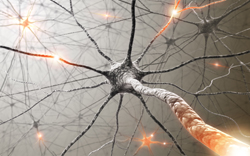Sometimes it takes two for nerve cell development
The progression from a stem cell that has no particular function and an undifferentiated structure to a fully operating neuron or nerve cell involves a complex web of chemicals. Add to that lifelong changes in nerve interconnections and the result is memory and an amazing basis for learning. Being able to control the changes from the undifferentiated cell to a neuron means that many neurodegenerative diseases like Parkinson's could have a cure. The EU-funded project 'Glial cell line-derived neurotrophic factor' (GDNF) took up the challenge of studying the project's namesake. GDNF is a chemical responsible for growth of many neurons in the central nervous system – brain and spinal cord. There are of course many other molecular players on the development field of a nerve cell. Project researchers centred their focus on two particular chemicals. First, a member of the GDNF family 'Rearranged during transfection' (RET), involved in sending messages, a signalling chemical. Second, but by no means least, acting along with RET, is Endothelin receptor type B (EDNRB). This molecule also acts as a signaller transferring chemical messages from outside to inside the cell. The two cellular communicators were found to have a special relationship with each other, specifically in the sphere of gut or enteron nerve cells in mammals. Together, the researchers found they played a large part of controlling the development. When EDNRB was activated, it enhanced the communication role of RET in the development of as yet 'uncommitted' gut nerve cells. Ironically, they can also act in opposition to each other, antagonistically, in the movement of progenitor cells, similar to stem cells, but further towards their final destiny as a differentiated nerve cell. To complete the picture, a chemical bridge between RET and EDNRB signalling systems was found An enzyme, protein kinase A, has many roles but in the enteric nervous system, it is one of the molecular entourage that link the two systems. Multifunctional molecules create a seemingly infinite number of possibilities for development pathways in biological systems. The work of this team in the GDNF consortium has filled in a small but important gap in the understanding of the mechanics of mammalian neuron development.







